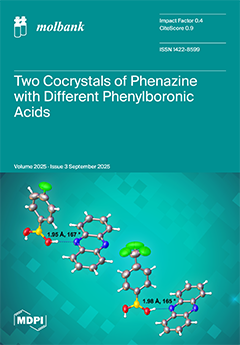A series of new amide-based cyclotriphosphazene molecules consisting of different terminal groups (heptyl, decyl, and tetradecyl) at the periphery was successfully synthesized and characterized. The reaction began with the alkylation of methyl-4-hydroxybenzoate with 1-bromoheptane, 1-bromodecane, and 1-bromotetradecane, which was followed by reduction with
[...] Read more.
A series of new amide-based cyclotriphosphazene molecules consisting of different terminal groups (heptyl, decyl, and tetradecyl) at the periphery was successfully synthesized and characterized. The reaction began with the alkylation of methyl-4-hydroxybenzoate with 1-bromoheptane, 1-bromodecane, and 1-bromotetradecane, which was followed by reduction with potassium hydroxide to form a series of benzoic acid intermediates (
1a–c). These intermediates underwent a reaction with thionyl chloride, followed by a reaction with 4-nitroaniline and triethylamine, to form para-substituted amides (
2a–c). Further reduction of intermediates
2a–c with sodium sulfide hydrate produced the anilines
3a–c. Another reaction of hexachlorocyclotriphosphazene (HCCP) with methyl-4-hydroxybenzoate yielded intermediate
4, which was then reduced with sodium hydroxide to form intermediate
5. Finally, chlorination of intermediate
5 with thionyl chloride, followed by a reaction with the aniline derivatives (
3a–c), formed the hexasubstituted cyclotriphosphazene compounds
6a–c, with two amide linkages. The structures of these compounds were confirmed using Fourier transform infrared (FTIR) spectroscopy, nuclear magnetic resonance (NMR) spectroscopy and CHN elemental analysis.
Full article





